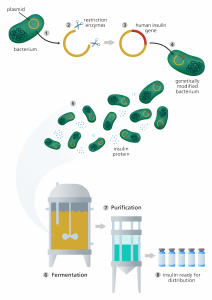22 Genetic Engineering
Andrea Bierema
Learning Objectives
Students will be able to
- Describe examples and mechanisms of genetic engineering.
- Define genetically modified organisms (i.e., GMO).
- Explain how CRISPR is used.
- Describe the role of Cas9 and the guide RNA in CRISPR.
- Identify key steps and their variations in CRISPR.
A variety of biotechnologies exist including cloning organisms, sequencing DNA, and modifying DNA. Although there is a wide range of molecular biotechnologies, this chapter focuses on changes to the genome, which results in changes in proteins or protein synthesis: genetic engineering.
Introduction to Genetic Engineering
Genetic engineering refers to the direct manipulation of DNA to alter an organism’s characteristics (phenotype) in a particular way. This may mean changing one base pair (A-T or C-G), deleting a whole region of DNA, or introducing an additional copy of a gene. It may also mean extracting DNA from another organism’s genome and combining it with the DNA of that individual. It has been used by scientists to enhance or modify the characteristics of an individual organism from a virus to sheep, to possibly humans. For example, genetic engineering can be used to produce plants that have a higher nutritional value or can tolerate exposure to herbicides.
We can change an organism’s characteristics by introducing new pieces of DNA into their genomes. This could be:
- DNA from the same species.
- DNA from a different species.
- DNA made synthetically in the lab.
There are several techniques that can be used to modify a genome, including:
Genetically Modified Organisms (GMOs)
Genetically modified (GM) organisms are organisms that have had their genomes changed in a way that does not happen naturally. By changing an organism’s genome, we change the resulting proteins, which change their characteristics. Any organism can be genetically modified, but laws restrict the creation of genetically modified humans, and the production and distribution of other GMOs are tightly regulated.
The first genetically modified organism was created in 1973 and was a bacterium. Then in 1974, the same techniques were applied to mice. The first genetically-modified foods were made available in 1994.
What is not a GMO? The genomes of organisms change naturally over time, and these natural changes are not classified as GMO (otherwise, everything would be classified as a GMO). Examples of natural changes include:
- when organisms mate, offspring get bits of DNA from both parents
- mutations arise as a result of mistakes when DNA is copied
- environmental factors like UV radiation can create changes in DNA.
The following video describes how genetically modified plants are made and which qualities may be desired.
An Example of Genetic Engineering: Insulin Production
Normally, insulin is produced in the pancreas, but in people with type 1 diabetes, there is a problem with insulin production. People with diabetes, therefore, have to inject insulin to control their blood sugar levels. Genetic engineering has been used to produce a type of insulin in yeast and in bacteria like E. coli that is very similar to our own. This genetically modified insulin, Humulin was licensed for human use in 1982.
To produce genetically-engineered insulin, a small, circular DNA called a plasmid is extracted from the bacteria or yeast cell. A small section is then cut out of the circular plasmid by restriction enzymes that act as “molecular scissors.” The gene for human insulin is inserted into the gap in the plasmid, creating a genetically modified plasmid.
This genetically modified plasmid is introduced into a new bacteria or yeast cell. This cell divides rapidly and starts making insulin. To create large amounts of the cells, the genetically modified bacteria or yeast are grown in large fermentation vessels that contain all the nutrients they need. The more the cells divide, the more insulin is produced. When fermentation is complete, the mixture is filtered to release the insulin. The insulin is then purified and packaged into bottles and insulin pens for distribution to patients with diabetes.

Mosquitos and the Lethal Gene
For another example of genetic engineering, check out HHMI Biointeractive‘s “Genetically Modified Mosquitos” video.
CRISPR
CRISPR-Cas9 is a genome-editing tool that is creating a buzz in the science world. It is faster, cheaper, and more accurate than previous techniques of editing DNA and has a wide range of potential applications. It can remove, add, and alter sections of the DNA sequence.
The CRISPR-Cas9 system consists of two key molecules that introduce a mutation into the DNA. These are:
Watch the following videos to learn about the CRISPR-Cas9 process.
In addition to the videos above, HHMI Biointeractive CRISPR Cas-9 Mechanism and Applications interactive is a great illustration!
The following is an overview of the different ways in which DNA is edited:
Exercise
Check your understanding of the CRISPR process!
Exercise
Want to learn more about what this looks like in a laboratory? Check out this simulation and this scrolling interactive from LabXchange!
Attributions
This chapter is a modified derivative of the following articles:
“What is CRISPR-Cas9?” by yourgenome, Genome Research Limited, 2019, CC-BY 4.0.
“What is a GMO?” by yourgenome, Genome Research Limited, 2017, CC-BY 4.0.
“What is genetic engineering?” by yourgenome, Genome Research Limited, 2017, CC-BY 4.0.
Media Attributions
- Insulin Genetic Engineering © YourGenome is licensed under a CC BY (Attribution) license

